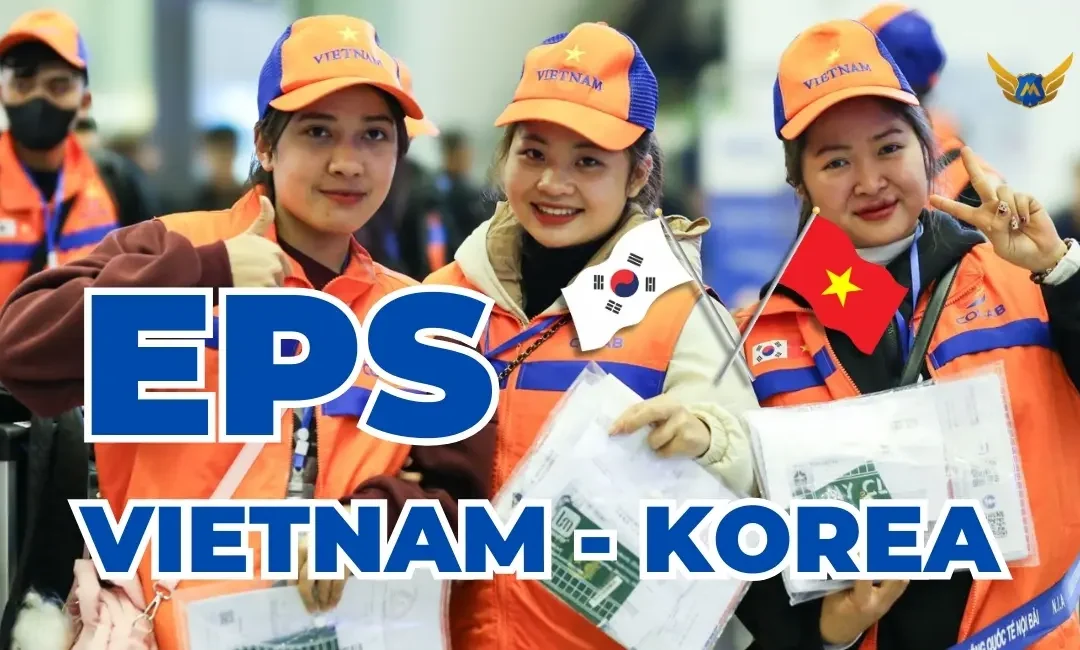Who this guide is for
Korean employers and international staffing firms seeking a legal, predictable, and scalable way to hire Vietnamese workers in manufacturing, construction, agriculture/fisheries, and selected services under Korea’s Employment Permit System (EPS). The article explains the system from the employer’s perspective, with concrete numbers and planning tips you can use immediately.
1) What exactly is the EPS Program Vietnam Korea?
The Employment Permit System (EPS) is the Republic of Korea’s state-managed framework that allows employers who face domestic labor shortages to legally hire foreign workers. It operates on a government-to-government (G2G) basis: Korea signs bilateral arrangements with partner countries, and recruitment is coordinated by the two governments. Vietnam has participated since 2004, making it one of the longest-standing and most consistent sources of workers for Korea.
Why it matters to employers
- Transparency & compliance: Recruitment is standardized and audited, reducing legal risk and eliminating illegal brokerage.
- Predictable supply: Candidate pools, testing schedules, and deployment steps are publicly structured.
- Worker protection: Contracts, wages, insurance, and working conditions are governed by Korean labor law—clear rules mean fewer surprises onsite.

2) Vietnam’s role & scale in EPS (numbers that matter)
- Since 2004, over 130,000–140,000 Vietnamese workers have gone to Korea through EPS.
- At any given time, tens of thousands of Vietnamese workers are active in EPS sectors, especially manufacturing and agriculture/fisheries, with additional demand in construction and selected service roles.
- Vietnam consistently ranks among the top sending countries by both volume and contract completion—useful for multi-year staffing plans.
Takeaway: Vietnam is a proven, high-capacity partner with reliable candidate pipelines and strong government oversight—ideal for employers who value continuity.
3) What roles can employers fill via EPS?
EPS (E-9 visa) is designed to meet shortages in 3D jobs (dirty, dangerous, difficult) where domestic supply is limited. Typical placements include:
- Manufacturing & Assembly: electronics, components, machinery operation, textiles, automotive parts.
- Construction & Skilled Trades: tiling, carpentry, concrete, general labor.
- Agriculture, Livestock & Fisheries: seasonal farming, greenhouse work, livestock care, fishing crews, seafood processing.
- Selected Services: cleaning, logistics support, hospitality tasks (depending on quota and policy).
4) Worker quality, compliance & retention
Why Vietnamese workers? Employers repeatedly cite strong work ethic, discipline, and fast adaptation to Korean shop-floor standards. Under EPS, workers typically receive pre-departure orientation in Vietnam and pre-employment training in Korea, so they arrive with baseline safety and cultural readiness.
Compliance foundations
- Covered by Korean labor law and the four major social insurances (National Pension, National Health Insurance, Employment Insurance, Industrial Accident Compensation).
- Standardized contracts and documented onboarding reduce disputes.
- Government monitoring and clear sanctions discourage early quits and illegal broker activity.
Retention levers you control
- Transparent pay rules (base wage, overtime, night/holiday rates).
- Predictable scheduling and dormitory standards.
- Bilingual supervision and safety briefings during the first 90 days.
- Mid-contract recognition (skills bonus, attendance incentives) to sustain motivation.
5) Wages, costs & planning assumptions (2025 reference)
- National minimum wage (2025): KRW 10,030/hour.
- Monthly reference (209 hours): KRW ~2,096,270 before overtime and allowances.
- Some regions publish higher living wage references (e.g., Seoul).
- Contract term: typically up to 3 years initially, with policy mechanisms that can allow re-employment/extension toward 4 years 10 months cumulative when criteria are met.
- Overtime & allowances: apply industry norms for night/holiday premiums; confirm any collective bargaining specifics in your locality.
- Insurance contributions: budget for employer portions of the four social insurances.
- Onboarding & training: plan for 1–2.5 weeks of pre-employment education in Korea, plus site induction.
Budget tip: For stable lines (electronics assembly), plan multi-year cohorts staggered by quarter. For seasonal sectors (fisheries/agriculture), align intakes with harvest/catch calendars to minimize idle time.
6) Language & skills standards (EPS-TOPIK and more)
- EPS-TOPIK (Korean language test) is mandatory; it focuses on workplace communication and safety. Scores are generally valid for 2 years.
- A common baseline is around 80/200 points, but selection is ultimately driven by employer demand and comparative scores.
- Many employers prefer candidates with prior factory or construction experience; pre-screening in Vietnam can filter by skill tags (e.g., soldering, forklift, tiling).
7) Step-by-step: How Korean employers hire from Vietnam via EPS
A. Employer side (Korea)
- Register demand with HRD Korea/MOEL: specify sector, worksite, job description, quota, wage, and conditions.
- Receive candidate rosters from the Vietnamese side (pre-screened applicants who passed EPS-TOPIK, skills/medical checks).
- Select candidates: review language scores, skill profiles, work history, and medical fitness; conduct permitted additional checks/interviews if available.
- Sign standardized employment contracts: confirm wage structure, hours, accommodation, and benefits in line with law.
- Immigration & deployment: process E-9 entry; coordinate worker arrival, pre-employment education, and site onboarding.
B. Candidate side (Vietnam)
- Register for EPS intake via official channels.
- Pass EPS-TOPIK and skills/medical screening.
- Enter the candidate pool; await employer matching.
- Contract → Visa → Pre-departure orientation → Flight → Onboarding.
Typical lead time: 8–16+ weeks from employer registration to worker arrival, depending on sector, quotas, exam cycles, and document readiness.
8) Risk management & compliance notes
- Preventing illegal stay: Clear work rules, fair treatment, and supportive supervision during the first 90 days reduce early attrition and compliance issues. Use regular 1-on-1 check-ins with bilingual leads.
- Safety & insurance: Confirm enrollment in all four insurances upon onboarding; maintain multilingual SOPs and visible safety signage.
- Dormitory standards & welfare: Reasonable room density, clean facilities, and access to basic amenities materially improve retention and productivity.
- Documentation integrity: Keep copies of contracts, payslips, attendance, and training records; audit quarterly.
- Crisis protocols: Prepare a playbook for medical incidents, worker grievances, and emergency travel—assign a bilingual liaison.
9) Program achievements & direction (why EPS is a safe bet)
- Two decades of proven cooperation with Vietnam and ongoing policy refinements give employers confidence to plan beyond a single season.
- Authorities continue to fine-tune quotas in high-demand sectors like manufacturing and agriculture, while encouraging legal migration and orderly returns.
- Many employers now build re-employment pathways for returnees who performed well, creating a virtuous cycle of productivity.
10) Budgeting snapshot for HR teams (quick checklist)
- Base wage: reflect the 2025 national minimum (KRW 10,030/h) and any local references (e.g., living wage).
- Premiums: overtime, night/holiday, productivity or skill bonuses where appropriate.
- Insurance costs: employer share of four social insurances.
- Accommodation & meals: decide whether to provide in-kind or cash allowances.
- One-time costs: onboarding, PPE, medicals not covered elsewhere, transport from entry point to site.
- Training time: 1–2.5 weeks pre-employment education + site induction; plan line buffers accordingly.
- Cohort cadence: quarterly intakes for stable demand; seasonal batches for agri/fisheries.
11) How Firstman Asia supports Korean employers (end-to-end)
- Demand planning & quota alignment: Map your roles to EPS categories, time requisitions to EPS-TOPIK cycles, and design rolling cohorts.
- Pre-screened shortlists: Verify language, skills, medical fitness, and authenticity of documents; filter by experience tags (e.g., SMT line, CNC, tiling).
- Compliance & documentation: Standardized contracts, insurance onboarding checklists, labor-law briefings for supervisors.
- Arrival & onboarding: Airport pickup, dormitory setup checklist, cultural refreshers, and bilingual safety training.
- Retention program: 30-60-90-day check-ins, team-lead coaching, and improvement feedback loops; KPI dashboards for attendance, output, and safety.
- Long-term partnership: Re-employment pathways for successful returnees; workforce planning horizon 3–5 years.
12) Quick FAQ for employers
Q1. Which visa applies under EPS?
E-9 (Non-professional Employment) for manufacturing, construction, agriculture/livestock, fisheries, and selected services. The permit-to-entry chain is coordinated by labor and immigration authorities.
Q2. How long can workers stay?
Typically up to 3 years initially, with policy mechanisms that can permit re-employment/extension toward 4 years 10 months cumulative when conditions are met.
Q3. What worker protections apply?
Standard Korean labor law plus the four major social insurances. Employers should maintain bilingual safety briefings, documented onboarding, and visible SOPs.
Q4. What language level is required?
Workers must pass EPS-TOPIK; scores are generally valid for 2 years. Higher scores improve selection chances but final matching is demand-driven.
📌 Are you looking for trusted Manpower supply agency in Vietnam?
Are you a company looking to recruit reliable workers from Vietnam, but still unsure where to start? Do you want to partner with a trusted and experienced Vietnamese manpower supply agency?
👉 Contact Firstman Vietnam today for a free consultation and discover how we can help you legally and efficiently hire skilled Vietnamese workers through the official EPS Program.
Firstman Vietnam – Trusted Manpower Solutions
- 📍 Office HCMC: 725/21 Trường Chinh, Tây Thạnh Ward, Ho Chi Minh City, Vietnam
- 📍 Office Hanoi: 8 Lê Văn Thiêm, Thanh Xuân District, Hanoi, Vietnam
- 📞 Hotline: +84-944-578-111
- 📧 Email: admin@firstman.vn
- 🌐 Website: www.firstman.asia
- Youtube: https://www.youtube.com/@firstman_vn
- Tiktok: https://www.tiktok.com/@firstman.vn
- Linkedin: https://vn.linkedin.com/company/firstman-asia

